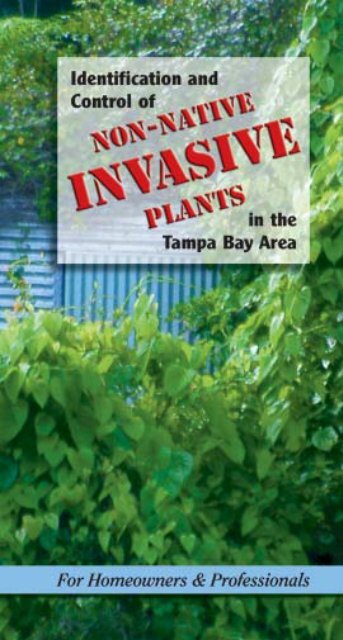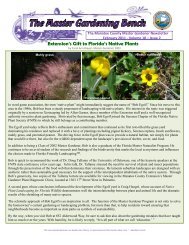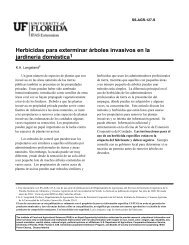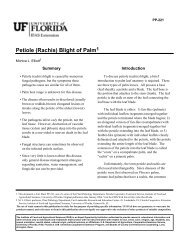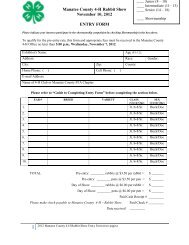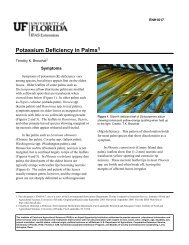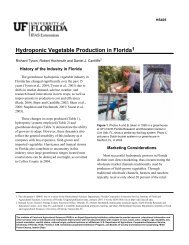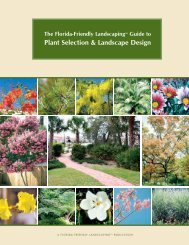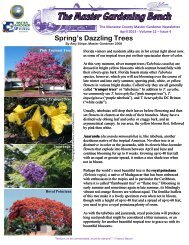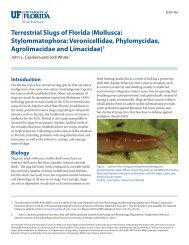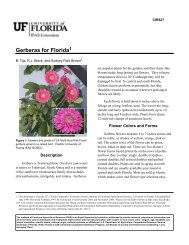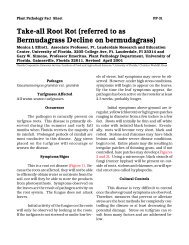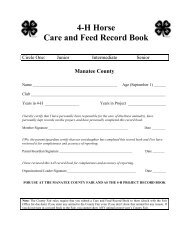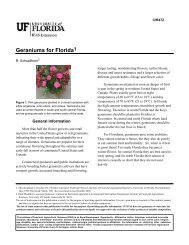Hillsborough County ISTF - Manatee County Extension Office ...
Hillsborough County ISTF - Manatee County Extension Office ...
Hillsborough County ISTF - Manatee County Extension Office ...
- No tags were found...
You also want an ePaper? Increase the reach of your titles
YUMPU automatically turns print PDFs into web optimized ePapers that Google loves.
This guide is intended and designed to be used by bothhomeowners and professional pesticide applicators.Public and private land managers and other professionalsworking in utilities, parks and conservation programs willalso find useful and educational information to aid inidentifying and controlling non-native invasive plants inthe Tampa Bay area. While there are more than 125 exoticspecies identified by the Florida Exotic Pest Plant Council(EPPC) as Category I or II pest plants, the InvasiveSpecies Task Force of <strong>Hillsborough</strong> <strong>County</strong>, Florida, hasselected 20 especially troublesome plant species found inthe Tampa Bay region. This field guide provides theinformation necessary to identify and chemically treatpest plants and includes replacement suggestions forreplanting once the targeted plants are controlled.The Florida EPPC regards Category I plants as: “Invasiveexotics that are altering native plant communities bydisplacing native species, changing community structuresor ecological functions, or hybridizing with natives.”Sixteen of the 20 species in this booklet are Category Ipest plants. The remaining four are Category II species—plants on their way to becoming Category I because of“increased abundance or frequency” in Florida plantcommunities.A non-native invasive is a plant from somewhere otherthan Florida that spreads aggressively into natural areas.All non-native plants are not invasive. They becomeinvasive when they outgrow and replace native plants innatural plant communities.Non-native invasive plants threaten our natural plantcommunities and pose ecological and financial impacts.Millions of dollars are spent each year to fight these pestplants. Local, state and federal governments, farmers andranchers, and other organizations play a role in thecontrol of non-native invasive plants. Ecologically, theseplants change the composition of natural plant andanimal communities. Many animal species that co-existand evolve with native plant communities cannot readilyadapt to rapid changes made to their habitats by nonnativeinvasive species. Invasive plants deplete the soil ofnutrients and moisture, block sunlight to native plants,prevent access to water (for animal species), depriveanimals of nesting areas and food sources, and provideideal conditions for yet other non-native species to invade.Areas with non-native invasive species tend to becomemonocultures (areas where one plant species dominates)and greatly reduce habitat diversity.
Features of the Field Guide4 ResourcesContact information of agencies and groupssupporting the control of non-native invasive pestplants and encouraging native plant replacements.5 Herbicide Application TechniquesThis guide promotes three different treatmenttechniques especially suited for homeowners andprofessionals.8 List of HerbicidesFor the homeowner and the professional.10 Plant DescriptionsEach of the 20 plants has:Identifying characteristicsA brief botanical description; for example, leaf shapeand color, flower color, and fruits.Color photographsAll the photographs in this guide were taken in theTampa Bay area!Scientific and common nameThe scientific name is in italics.HabitatA brief description of where the plant is found andmost likely to thrive.Growth habitsHow the plant spreads; for example, are the seedsdispersed by birds or do the plants spread by roots?Control methodsTips on controlling and eradicating the plants.ReplacementsFlorida native plant species are recommended.47 The Invasive Species Task ForceWhat it is and how you can get involved.48 SourcesCover photo: Air potato in <strong>Hillsborough</strong> <strong>County</strong>2
Plant List10 Air potato and Air yam ........ Dioscorea spp.12 Australian-pineand SuckeringAustralian-pine .................... Casuarina spp.14 Brazilian pepper .................. Schinus terebinthifolius16 Carrotwood tree .................. Cupaniopsisanacardioides18 Chinaberry tree ................... Melia azedarach20 Chinese tallow tree,Popcorn tree ........................ Sapium sebiferum22 Cogon grass ......................... Imperata cylindrica24 Guinea grass ........................ Panicum maximum26 Japanese climbing fern andOld World climbing fern ..... Lygodium spp.28 Kudzu vine .......................... Pueraria montana30 Lead tree, Jumbie bean ....... Leucaena leucocephala32 Melaleuca, Punk tree........... Melaleuca quinquenervia34 Mexican petunia .................. Ruellia tweedianaMexican bluebell ................. R. brittonianaBritton’s wild petunia36 Rosary Pea, Crab’s eyes ....... Abrus precatorius38 Skunk vine .......................... Paederia foetida40 Torpedo grass,Bullet grass .......................... Panicum repens42 Tropical soda apple .............. Solanum viarumPlants of Growing Concern:44 Castor bean .......................... Ricinus communis45 Camphor tree ...................... Cinnamomum camphora46 Paper mulberry ................... Broussonetiapapyrifera 3
Invasive Species Task Force<strong>Hillsborough</strong> <strong>County</strong> Parks,Recreation and ConservationCockroach Bay AquaticPreserve, 3709 Gulf City Road,Ruskin, Florida 33570813-671-7754 or 813-672-7876Tampa Bay Estuary Programwww.tbep.orgSouthwest Florida WaterManagement Districtwww.watermatters.org800-423-1476, ext. 4537<strong>Hillsborough</strong> <strong>County</strong><strong>Extension</strong> Servicehillsborough.extension.ufl.eduLink to Florida’s <strong>County</strong><strong>Extension</strong> Service <strong>Office</strong>s:www.ifas.ufl.edu/extension813-744-5519Florida Department ofEnvironmental Protection,Bureau of Invasive PlantManagementwww.dep.state.fl.us/lands/invaspec850-245-2809Florida Exotic Pest PlantCouncilwww.fleppc.orgResourcesThe Tampa Bay area has many resources available to assistwith controlling non-native plant species and replantingnative plants. Listed below are helpful names, numbersand/or Web sites of agencies and groups.Native Plant and Non-native Invasive Plant InformationHerbicide and Chemical InformationBASF Vegetation Managementwww.vmanswers.comUPM Corp.www.vine-x.comsales@vine-x.com877-650-84634U.S. Fish and Wildlife Servicesoutheast.fws.gov/ea/Fun_Facts/fun_index.htmlUniversity of FloridaInstitute of Food andAgricultural Sciences,Center for Aquatic andInvasive Plantsplants.ifas.ufl.edu352-392-9613U.S. Department ofAgriculture, NaturalResources ConservationServiceplants.usda.govInvasive and Exotic Speciesof North Americawww.invasive.orgEnvironmentalProtection Agencywww.epa.gov/oppt/labelingwww.epa.gov/owow/invasive_species/Florida Native Plant Societywww.fnps.org772-462-0000Florida Plants Onlinewww.floridaplants.comwww.roundup.comwww.dupont.com/ag/vm/products/escortxp.htmlwww.dowagro.comwww.ortho.com
Herbicide Application TechniquesHerbicide application is a control method in which aherbicide is applied directly to the targeted nuisancevegetation via one of several application techniques.Although there are many effective treatment methods,this field guide will describe three different applicationtechniques suitable for homeowners and professionals.The three techniques are foliar, basal bark and cut-stump.The foliar method involves the application of the herbicidedirectly to the leaves of the plant, while the basalbark technique treats the bark of the plant at or nearground level. The cut-stump method requires the plant tobe cut down and the herbicide applied immediatelyfollowing and directly to the cut surface of the stump.This guide indicates the most effective applicationtechnique(s) for each invasive plant species. Utilizing theappropriate method greatly increases the effectiveness oftreatment and reduces the need for retreatment. However,it is important to note that with the aggressive nature ofinvasive plant species, repeated treatments are oftennecessary depending on the type and extent of aninfestation, effectiveness of the herbicide, and propertechnique selection and application. (Treatmentspresented in this guide indicate control techniques usedby Invasive Species Task Force participants.)The most effective time to apply herbicides is during thespecific growing season of the plant being treated,particularly before seeds are fully developed and dispersedby wildlife. Generally, new vegetation is most vulnerableto herbicides and most readily absorbs the chemical.Please refer to the “Control” section of each species forspecific eradication tips.Foliar ApplicationsThis technique involves applying water-based herbicidedirectly to the leaves and stems of a plant. Herbicides maybe applied to the foliage of the plant using handheld spraybottles, pump sprayers and backpack sprayers. Wettingagents (surfactants) may be added to the mix to furtherenhance leaf coverage. This equipment is available athome improvement stores, garden centers or by mailorder from companies specializing in gardening supplies.For small areas, products with wick or wipe-on applicatorswork well. Foliar treatment of large infestationsutilizes power-driven ground sprayers with boom5
attachments to ensure adequate coverage. It is importantto remember that when using the foliar method, theherbicide may aerially drift and harm or kill non-targetplants. Be sure to follow instructions on the herbicidelabel.Basal Bark ApplicationsThis technique consists of applying oil-based herbicidesdirectly onto the bark. Herbicides used in this method areformulated to be absorbed through the bark of the tree.Apply herbicide around circumference of the stem/trunkup to 12 to 20 inches above the ground using a handheldspray bottle or pump sprayer. Old or rough bark mayrequire more herbicide than smooth young wood. Spray towet, but not to the point of run-off. Wind drift is less of afactor when basal bark spraying, but still should be aconsideration.Cut-Stump ApplicationsThe cut-stump method is most effective for plants prone toresprouting. After mechanically cutting down the invasiveplant, the herbicide is painted, sprayed or squirted directlyonto the cut surface of the stump or stem on the circumferenceof the exposed cambium. The cambium is the layerjust inside the bark that provides the tree/plant with newcells for growth. For smaller stems, simply coat the cutstem(s). The stump should be cut as level as possible toprevent herbicide run-off, and herbicide should be appliedimmediately following the cut to increase herbicideeffectiveness—i.e. prevent resprouting. Be sure to removethe sawdust from the stumps before treatment. Lowpressureequipment, such as handheld spray bottles, pumpsprayers or even a paintbrush, are appropriate tools for thecut-stump technique.Herbicide Application Tips• Consult your county extension service (see Resourceson page 4) for more detailed information about bestpractices. Using more is not better and can harmdesirable plants.• Always read the product label before use. Before usingany herbicide or chemical, read the label carefully,thoroughly understand all prohibitions and follow alldirections. Remember, the label is the law!• Always wear recommended protective clothing andequipment when handling herbicides.6
• Buy the right amount for your needs. Some productsmay not work well if stored for long periods of time. Alarger size might not be a good value if you can’t use it.• Prevent harm to the environment. Chemicals that runinto ponds, creeks or other water can contaminate thewater and kill fish and other wildlife. When workingaround water sources, be sure to use chemicalsapproved and labeled for such use.• Never pour lawn and garden products down a drain. Ifyou can’t use the entire product, pass it on to someonewho can. Contact your local Solid Waste Departmentfor your community household chemical collectionprogram.• Use care when applying herbicides using sprayequipment. Protect and/or cover all non-target plantsfrom overspray or wind drift.• The addition of a water-soluble dye can assist in trackingwhether spray drift has reached non-target plants. Thisalso helps determine complete coverage of target plants.• When changing from a water-based mix to an oil-basedmix in a sprayer, run a small amount of oil through thepumping system before filling with oil-based mix;otherwise a white “sludge” will clog the sprayer.• Consult your county extension service or native plantnurseries for a list of native plants suitable for replacinginvasive non-native plants. This guide has providedsome suggestions.• Do not wash work clothes with family laundry.• Do not eat, drink, use tobacco products, or use thebathroom while using herbicides.• Keep children and pets away from herbicides andtreated areas.Dilutions• All dilutions of Garlon 4 applications (except foliar)are made with oil. Brush B Gon® and Pathfinder IImay not need to be diluted.• All dilutions of Rodeo®, Roundup®, Escort® XP,Plateau®, GroundClear®, Arsenal®, Garlon 3A orRenovate 3 are made with water. Always use cleanwater in a herbicide mixture and mix granularsolutions in a bucket, not in the sprayer. Stir for severalminutes before transferring to sprayer.7
WATER-BASED HERBICIDES (FOLIAR APPLICATIONS)Chemical Name Product Name 1 CommentsGlyphosate 53.8% Rodeo® May be applied in water, requires a surfactant. 2Glyphosate 41.0% Roundup® Super Concentrate Weed Discontinued; but still available.& Grass Killer May not be applied in or over water.Glyphosate 27.0% Roundup® Poison Ivy & Tough Brush May not be applied in or over water.Killer ConcentrateGlyphosate 25.0% Roundup® Weed & Grass Killer Concentrate May not be applied in or over water.Glyphosate 5.0% Ortho® GroundClear® Complete Vegetation May not be applied in or over water.Imazapyr .08% Killer Concentrate (Formerly Triox®)Imazapic 23.6% Plateau® May not be applied in or over water.Imazapyr 28.7% Arsenal® May not be applied in or over water.Metsulfuron Escort® XP Granular; mix in water, requires a surfactant. 2methyl 60.0% May be applied in or over water.Triclopyr amine 8.0% Ortho® Brush B Gon® May not be applied in or over water.Triclopyr amine 44.4% Garlon 3A or Renovate 3 May be applied in or over water per label.8
WATER-BASED HERBICIDES (CUT-STUMP APPLICATIONS)Imazapyr 28.7% Arsenal® May be applied to trees in standing water perSLN label directions.Triclopyr amine 44.4% Garlon 3A or Renovate 3 May be applied to trees in standing water. Maybe applied in or over water per label.OIL-BASED HERBICIDES (BASAL BARK AND CUT-STUMP APPLICATIONS)Triclopyr ester 13.6% Pathfinder II May not be applied in or over water.Triclopyr ester 13.6% Vine-X Vine & Brush Control See Resources for Web site and phone number.Packaged for easy application with brushattached. May not be applied in or over water.Triclopyr ester 61.6% Garlon 4 May not be applied in or over water.This guide provides the most up-to-date and effective herbicides and treatment techniques for the non-native invasiveplants in this guide. Chemical companies are continually improving herbicides targeting non-native invasive species.Listed here are some names of herbicide products available to the general public at home improvement stores, gardencenters or farm supply stores, as well as products marketed to professionals. This is not an exhaustive list; there are manyother products available. Always read the product label before use. Always use personal protective equipment (PPE).1 This list is not necessarily an endorsement by any of the parties involved with this field guide.2 Surfactant: Wetting agent that allows the chemical to “stick” to foliage rather than run off.9
Fruits and leaves of Airyam (right) are longerthan those of Air potato(below). The fruits growin the leaf axils. Theyhave been placed on theleaves in these photos toshow their shape, relativeto the leaf.10
Air potatoAir yamDioscorea spp.D. bulbiferaD. alataIdentifying CharacteristicsHerbaceous vines with stems up to 60 feet or more inlength, twining counterclockwise and covering trees andshrubs. Leaves are alternate (D. bulbifera) or opposite (D.alata), heart-shaped, up to 8 inches or more in length;bright or dark green in color. Aerial tubers or bulbils(“potatoes”) are round, mostly smooth, but can be bumpyor rough; form in the leaf axils. Bulbils range from pea togolf ball to tennis ball size, but can grow to approximately5 inches across. Some species, such as D. alata, produceunderground tubers. Flowers are rarely seen and aresmall—in spikes to 4 inches long. Fruits are capsules withpartially winged seeds.Note: Often confused with Kudzu, but leaf shape ischaracteristic.HabitatCommonly found in residential areas, growing on fencelines and trees, especially in shady areas. Found in vacantlots, climbing high into trees and over the ground.Invades a variety of habitats including wetlands,pinelands, hammocks and even landfills.Growth HabitsReproduces prolifically from large numbers of aerial andunderground tubers. Vines sprout even from small tubers.Bulbils float, aiding in dispersal. Has a dormant period inwinter, dropping the bulbils which sprout in the spring.Control Methods: Foliar or Cut-StumpDuring growing season (spring to mid-summer), cut vinesto waist high and apply triclopyr amine or glyphosate.Remove tubers during winter months when vines havedied back. Carefully dispose of all plant material andtubers/bulbils in plastic bags; incinerate if possible.Follow-up applications of herbicide are necessary.ReplacementsIn most cases, a replacement is not necessary or desirable.However, native vine replacements include:Moonflower vine (Ipomoea alba)Carolina jessamine (Gelsemium sempervirens)11
Australian-pineSuckering Australian-pineCasuarina spp.C. equisetifoliaC. glaucaIdentifying CharacteristicsThere are two common species of Australian-pine and oneless frequently found in Florida. Australian-pine (C.equisetifolia) is an evergreen tree to 150 feet. Usually hasa single trunk with reddish-brown to gray bark. Althoughthe tree resembles a pine, close inspection of the plantreveals branchlets (not needles) that are jointed, thin,grayish-green, needle-like and 4 to 8 inches long. Seedsform in woody, cone-like clusters about 3 /4 inch long and1 /2 inch wide; produced year-round.Suckering Australian-pine (C. glauca) grows to 70 feet tallwith a pyramidal shape. Bark is dark gray-brown andscaly. Needle-like branchlets are 8 to 10 inches long andjointed, thin and sometimes waxy. Differs from C.equisetifolia in having separate male and female plantsand 10 to 17 leaf scales per branchlet and smaller seeds.There is a less common third species, C. cunninghamiana,the most cold hardy of the three species.HabitatIntroduced to Florida in early 1900s and planted aswindbreaks and shade trees. Found in abundance fromOrlando throughout south Florida on sandy shores,pineland and sawgrass marshes. Colonizes in disturbedsites such as road shoulders and undeveloped lots.Growth HabitsGrows extremely fast—5 to 10 feet per year. Creates densestands that displace native plants and wildlife. Trees blowover easily in storms because of shallow root systems.Seeds are dispersed by birds, water and wind. SuckeringAustralian-pine (C. glauca) reproduces aggressively fromwidely spreading roots, especially when pruned.Control Methods:Cut-Stump or Basal BarkLarge trees should be cutand treated immediatelywith triclopyr ester. Basalbark applications are alsoeffective.ReplacementsLongleaf pine (Pinuspalustris)Slash pine (Pinus elliottii)Red cedar (Juniperusvirginiana)13
Brazilian pepperSchinus terebinthifoliusIdentifying CharacteristicsBrazilian pepper is a large, multi-trunked shrub or treewith arching and crossing branches; can grow to 40 feettall, forming thickets. Leaves are evergreen, glossy greenand alternate. Often toothed, leaves are compound with 3to 11 (usually 7 to 9) leaflets. Leaflets vary in shape, butare generally found elliptic to oblong and 1 to 2 incheslong. Crushed leaves smell peppery or like turpentine.Female plants form small white flowers almost everymonth of the year, but most profusely in the fall season,producing clusters of red berries.Brazilian pepper is a relative of poison ivy and poisonsumac. Sap may irritate skin and pollen may causerespiratory irritation.HabitatWill readily invade residential and urban landscapes.Invades undisturbed areas—hardwood hammocks,mangrove forests and pinelands, as well as disturbed areassuch as roadsides, ditches, and fallow farmland.Growth HabitsFound especially in moist, organic soils, but will grow inany soil type. Is salt-tolerant, able to withstand flooding,fire and drought. Sprouts easily from trunk and roots.Seeds spread by wildlife (bird and small mammals)consumption.Control Methods: Cut-Stump or Basal BarkUse gloves when working with Brazilian pepper. Avoiddropping berries—collect and dispose of in plastic bags. Ifpossible, schedule removals in late summer or early fallbefore new berries have ripened. Note: Even the greenberries will ripen after cutting the branch. If handcutting,dig up as much of the root system as possible.Larger trees should be cut to the ground and stumpstreated immediately with triclopyr ester. Basal barkapplications are also effective.ReplacementsNecklace pod (Sophora tomentosa)Dahoon holly (Ilex cassine)Walter’s viburnum (Viburnum obovatum)Wax myrtle (Myrica cerifera)15
Carrotwood treeCupaniopsis anacardioidesIdentifying CharacteristicsUsually a single-trunked tree, rapidly growing 30 to 35feet tall. Outer bark is dark gray; inner bark often orange(carrot color). Leaves are evergreen, alternate andcompound, shiny and leathery, up to 8 inches long with 4to 12 oblong leaflets. Produces white to yellow-greenflowers in clusters in late winter or early spring. Fruitsare segmented capsules, about 1 inch and yellow toorange when ripe; brown when dry. Fruits split to reveal 3seeds coated with a striking orange crust.HabitatIntroduced as a landscape plant in the 1960s. Invadescoastal sites including spoil islands, beach dunes,marshes, mangroves, cypress swamps, and coastal strands.Found established in various habitats on both coasts ofFlorida. Also invades upland sites including pinelands andscrub. Especially problematic to mangrove ecosystems.Growth HabitsGrows in wet and dry areas, in any soil type, in full sun orfull shade, and is salt- and freeze-tolerant. Seeds dispersedby birds and also seeds freely from plantings. Shades outnative vegetation.Control Methods: Cut-Stump or Basal BarkCut larger trees and apply triclopyr ester immediately.Basal bark applications of triclopyr ester are also effective.Dispose of seeds in plastic bags. May require follow-uptreatments.ReplacementsReplacement trees should provide shade and food forwildlife.Wax myrtle (Myrica cerifera)Florida privet (Forestiera segregata)Gumbo-limbo (Bursera simaruba)Green buttonwood (Conocarpus erectus)Dahoon holly (Ilex cassine)Yaupon holly (Ilex vomitoria)Sweetbay magnolia (Magnolia virginiana)17
Chinaberry treeMelia azedarachIdentifying CharacteristicsDeciduous tree growing to 50 feet tall. Chinaberry is amulti-branched tree with dark, chocolate brown barkbecoming increasingly fissured with age. Evident whitelenticels (dots) mark the glossy brown stems. Leaves arealternate, two or three times compound, and grow up to1 1 /2 feet long. Leaflets are dark green and lacy in appearance.Flowers are small and lilac-colored; fruits are roundyellow to yellow-green and hang in clusters. Fruits arefleshy, single-seeded and ripen late summer.Bark and leaves are poisonous to domestic animals andlivestock, and fruits are poisonous to humans and somemammals, including livestock.HabitatFound primarily in disturbed areas such as roadsides andfencerows, but has also been found in marshes and uplandwoods. Most abundant in north and west Florida, butfound as far south as the Keys.Growth HabitsSpreads by seed drop and dispersal by birds. Sprouts fromroot collars, forming colonies from root sprouts. Shadesout native vegetation.Control Methods: Cut-Stump or Basal BarkLarge trees should be cut and treated immediately withtriclopyr ester. Basal bark applications are also effective.Roots are very deep and difficult to pull up. Revisit site topull seedlings.ReplacementsLaurel oak (Quercus laurifolia)Bluejack oak (Quercus incana)Flatwoods plum (Prunus umbellata)Chickasaw plum (Prunus angustifolia)Red mulberry (Morus rubra)19
Chinese tallow treePopcorn treeSapium sebiferumIdentifying CharacteristicsDeciduous tree with milky sap, growing to 60 feet tall.Leaves alternate and ovate with broadly rounded basesthat taper to slender points, somewhat heart-shaped.Leaves turn yellow to red in fall. Flowers small, yellow, inspikes; occur in spring. Fruits are capsules, green turningbrown and splitting open to reveal three white seeds inlate summer to early fall. Seeds often remain attachedthroughout winter and resemble popcorn.Sap is milky and poisonous.HabitatInvades stream banks, roadside ditches and wet areas, butalso grows in upland areas. Shade- and salt-tolerant.Growth HabitsIntroduced as an ornamental and as a potential oil cropspecies. Early growth is very rapid, with onset of flowersand fruit when the tree reaches approximately three feetin height. Young trees establish a taproot system thatallows the tree to withstand extended periods of drought.Seeds dispersed by birds and by water. Suckers fromstumps.Control Methods: Cut-Stump or Basal BarkApply triclopyr amine to freshly cut stump or triclopyrester as basal bark or cut-stump treatment in late springor early summer after mature leaves have developed, andbefore seeds have developed. Reapplications may benecessary. Pull seedlings by hand. Dispose of seeds inplastic bags.ReplacementsBlack gum (Nyssa sylvatica var. biflora)Red maple (Acer rubrum)Persimmon (Diospyros virginiana)Cedar elm (Ulmus crassifolia)Turkey oak (Quercus laevis)Post oak (Quercus stellata)21
22The midvein is offcenterin Cogon grassleaves (right).
Cogon grassImperata cylindricaIdentifying CharacteristicsAggressive perennial grass, growing in tufts fromextensive rhizomes. Considered one of the top 10 worstweeds in the world and a pest in 73 countries. Erect,narrow leaves, up to 5 feet tall, with whitish, noticeablyoff-center midvein. Leaves are yellow-green, sharplypointed and hairy at the base. Leaf blades also havescabrous (rough to the touch) margins. Flowers are whitesilky plumes up to 8 inches long, found year-round insouth and central Florida.HabitatIntroduced for forage and soil stabilization. Commonlyfound in open forests, fields, pastures and along transportationand utility corridors. Thrives in areas of minimaltillage.Growth HabitsFast-growing. Grows in full sunlight to partial shade inany area without standing water. Disperses by windborneseeds and by extensive rhizomes. Often spread byfragmentation on farm and roadway machinery. Highlyflammable and aggressively invades after fire.Control Methods: FoliarControl in late fall when leaves are bright green. Mowbefore seed heads have set, then wait until grass grows to6 inches to apply glyphosate or imazapyr. Repeat applicationsmay be necessary. Landowners may need a covercrop if treating large areas.ReplacementsEastern gamma/Fakahatchee grass(Tripsacum dactyloides)Love grasses(Eragrostis elliottii or E. spectabilis)23
Guinea grassPanicum maximum(sometimes listed as Urochloa maxima)Identifying CharacteristicsOriginally from Africa; introduced agriculturally asanimal fodder. Leaves are long and narrow, flat and brightgreen, fine and soft. Hairy leaves, 1 /2 to 1 1 /4 inches wide,can grow 5 to 39 inches long. Margins are glabrous(smooth or hairless). Tiny flowers are on inflorescentspikelets and are green or tinged with purple. Plants cangrow 3 to 9 feet tall.HabitatGrows naturally in open grasslands. Usually formscolonies under or near trees and shrubs on abandonedcultivated land, fields and wastelands.Growth HabitsConsidered an invasive weed because the grass suppressesor displaces local plants. This tufted perennial grassusually grows in large bunches from short stout rhizomesand grows on a wide variety of soils, in both sun andshade. Can survive long, dry periods, as well as fire. Theunderground rhizomes are not harmed by fire and maytherefore dominate after a fire. Responds quickly towatering and fertilizer. Seeds are dispersed by wind, birdsand flowing water.Control Methods: FoliarMow, then wait until grass grows to 6 inches to applyglyphosate or imazapyr. Reapplications will be necessary.ReplacementsMuhly grass (Muhlenbergia capillaris)Love grasses(Eragrostis elliottii or E. spectabilis)Eastern gamma/Fakahatchee grass(Tripsacum dactyloides)25
Leaves of Old Worldclimbing fern (top)grow more finelydivided as theymature (facing page).Leaves of Japaneseclimbing fern (left)are “lacy.”A mass of Japaneseclimbing fern isshown below.26
Japanese climbing fernOld World climbing fernLygodium spp.L. japonicumL. microphyllumIdentifying CharacteristicsClimbing and twining perennial viney ferns that grow to90 feet. Vines arise from underground, widely creepingrhizomes. Wiry stems may be green to orange, turningdark brown or black. Leaves are finely divided/dissectedwhen mature and bright green in color. Leaves vary inappearance according to the number of divisions in theleaflet and species. L. japonicum leaves have a “lacy”appearance. Leaves are 2 to 6 inches long and 2 to 3inches wide.HabitatThese ferns occur in disturbed areas such as alongsidebridges, roadside ditches and fence lines. Also commonlyfound along stream and swamp margins and open forests.Growth HabitsWill grow in shady or sunny areas. Flooding will not killthe ferns; will also thrive in shallow water, as well as dryareas. The ferns form mats up to 4 feet thick on trees andshrubs, smothering trees and native vegetation. The vinesare mostly deciduous by late winter—or turn dark to tanin winter. Vines that have died back provide a trellis fornext season’s growth. Reproduce by millions of sporesspread by wind and other physical carriers.Control Methods: Cut-Stump or FoliarCut to knee- or waist-high then apply glyphosateimmediately or foliar spray using glyphosate andmetsulfuron methyl with care if treating around desirableplants. Care should be taken toremove upper fronds, as spores maystill be viable. Dispose of deadmaterial in plastic bags. For bestresults, control this plant from Julyto October during its active growth.Reapplications will be necessary.ReplacementsCinnamon fern (Osmundacinnamomea)Royal fern (Osmunda regalis)Chain fern (Woodwardiavirginica)27
Kudzu vinePueraria montana var. lobataIdentifying CharacteristicsA deciduous, twining, trailing, mat-forming vine withrope-like brown woody stems. Kudzu can grow 35 to 100feet long. Pinnately compound leaves have three leafletsand are alternate and bright green. Tips of leaflets arepointed and usually slightly lobed (unless growing in theshade). Each leaflet is 3 to 7 inches long and 2 1 /2 to 8inches wide with fine hairs on leaf margins. Young stemsand leafstalks are hairy. Flowers are 2- to 12-inch-longracemes of pea-like flowers, opening from the base to thetop. Petals are lavender to wine colored with yellowcenters; flowers June to September. Fruits are clustered,dry, flattened, wide bean pods. Pods are 1 to 3 inches longand up to 1 /2 inch wide. Immature pods are green,ripening to tan and covered with stiff golden-brown hairs.The pods split on one or two sides to release a few seeds.Note: Often confused with Air potato, but leaf shape isusually the identifying characteristic.HabitatOccurs along streams, rights-of-way, along roadsides andanywhere else it can twine around.Growth HabitsKudzu is drought-tolerant, and forms dense mats over theground, debris, shrubs and trees by twining on objectsless than 4 inches in diameter. Can kill a tree by blockingout all sunlight. The vine produces roots at its nodes.Spreads by wind, birds and mammals, and water-dispersedseeds.Control Methods: Cut-Stump or FoliarUse foliar method with care if treating around desirableplants. Cut vine to waist level and apply glyphosateimmediately. Best results occur after Kudzu has floweredand/or when vine has eight leaves or more, from July tothe first killing frost. Reapplications may be necessary.ReplacementsIn most cases, a replacement is not necessary or desirable.However, native vine replacements include:Moonflower vine (Ipomoea alba)Coral honeysuckle (Lonicera sempervirens)Carolina jessamine (Gelsemium sempervirens)29
Lead treeJumbie beanLeucaena leucocephalaIdentifying CharacteristicsRapidly growing shrub or tree from the legume familythat grows to 60 feet. Leaves are Mimosa-like with 11 to24 (usually about 15 pairs) elliptic, light green leafletsthat are about 1 /2 inch long. Leaves are bipinnatelycompound, and grow to 5 to 7 1 /2 inches long. Bark isfissured with abundant lenticels (distinct white dots) ontrunk. Flowers are yellowish-white in round “puffs,”blooming in the summer. Large, flat, reddish-brown beanpods hang in clusters (4 to 10 per leaf). Each pod containsat least 15 oval, glossy brown seeds.HabitatFound in disturbed sites, pinelands and hammocks alongthe coastal zone. Has become a nuisance tree due to itsability to out compete native species.Growth HabitsPrefers alkaline soils, full sun and warm temperatures.Lead tree will die back with mild frosts, but will rapidlyregrow from deep roots. Highly drought-tolerant onceestablished, but will not stand water-logged conditions.Control Methods: Cut-Stump, Basal Bark or FoliarCut trees and apply triclopyr ester immediately. Basalbark applications are also effective. Foliar spray smalltrees (less than 4 feet tall) with glyphosate andmetsulfuron methyl.ReplacementsSaffron plum (Sideroxylon celastrinum)Yaupon holly (Ilex vomitoria)Sweet acacia (Acacia farnesiana)Hercules’ club (Zanthoxylum clava-herculis)31
32Melaleuca bark(right) is papery,with many peelinglayers. The flowers(below) look likebottle brushes.
MelaleucaPunk treeMelaleuca quinquenerviaIdentifying CharacteristicsMelaleuca is a rapidly growing tree that can reach 100feet. Identified by its white, many-layered peeling bark.Narrow, grayish-green, lance-shaped leaves are 2 to 8inches long and 1 /2 inch wide; smell of camphor whencrushed. Flowers year-round in creamy white “bottlebrush” spikes that are 6 inches long. Fruits are small,brown, woody cone-like clusters that surround youngstems. Each cone-like cluster may hold up to 300 tinyseeds.May cause headaches, rashes, asthma attacks andrespiratory irritation in certain people.HabitatPrefers wet sites such as lake shores, swamps andwetlands, but also flourishes in standing water. Willsurvive in well-drained uplands such as residential yards.Mature trees can survive frost damage and fire damage.Melaleuca will displace native vegetation with its rapidcolonization.Growth HabitsSprouts easily from stumps and roots. Spreads rapidly,creating thickets. Produces up to 20 million windborneseeds per year per tree; tends to release seeds whenstressed.Control Methods: Cut-StumpLarge trees should be cut and stumps treated immediatelywith triclopyr ester or imazapyr. Pull seedlings by hand.Retreatments may be necessary.ReplacementsPignut hickory (Carya glabra)Water hickory (Carya aquatica)In wetland areas:Pop ash (Fraxinus caroliniana)Sweetbay magnolia (Magnolia virginiana)In upland areas:Southern magnolia (Magnolia grandiflora)33
Mexican petuniaRuellia tweedianaMexican bluebell Ruellia brittoniana(sometimes listed as Britton’s wild petunia)Identifying CharacteristicsPerennial herb with a white, pink or lavender to purpleflower on an erect green stem. May grow to 3 feet tall,although there are dwarf or compact varieties. Leaves areopposite, linear-lanceolate to linear-elliptic, up to 1 inchwide and up to 10 inches long. Veins are prominentlyraised on the underside of the leaf, margins are smooth orwavy and tips are pinched to a point. Light pink to bluishpurpleflowers are solitary or in clusters and flowerthroughout most of the year in Florida. Fruit is acylindrical capsule containing 4 to 20 tiny seeds.HabitatPresumably introduced as an ornamental plant; nowfound from Louisiana down the peninsula of Florida.Forms invasive, dense rhizome colonies in marshy or wetareas. Tolerates a wide variety of soil types. Grows well inboth shade and sun, and tolerates heat and drought,therefore dominates creek beds, pine flatwoods, hardwoodhammocks, prairies, rivers and pastures; excludes nativegroundcover wherever it invades.Growth HabitsPlants spread readily from seeds, rhizomes, stem sproutsand cuttings. Each plant can produce thousands of viableseeds each season. May freeze back in winter, but willresprout from the roots.Control Methods: FoliarUse foliar method with care if treating around desirableplants. Cut larger plants down and apply glyphosate. Pullseedlings up by hand.ReplacementsWild petunia (Ruellia caroliniensis)Blue curls (Trichostema dichotomum)Butterflyweed (Asclepias tuberosa) for dry areasSwamp milkweed (Asclepias perennis) for wet areas35
Rosary peaCrab’s eyesAbrus precatoriusIdentifying CharacteristicsA high climbing (10 to 20 feet), twining or trailing woodyvine with slender green branches. Leaves are alternate, 2to 5 inches long, even-pinnately compound with 5 to 15pairs of leaflets. Each leaflet is oval to oblong and lessthan 1 inch long. Flowers are shaped like pea flowers;small and white to pink to reddish in color. Prolificflowers and fruits in the summer. The fruit is a short,oblong pod that splits before falling, revealing 3 to 8shiny, hard, scarlet red seeds with black bases. Each redseed is about 1 /4 inch in diameter.Seeds are extremely poisonous to humans, cattle andhorses.HabitatInvades pinelands and hammocks. Naturalized in roadsideareas, waste areas and along fencerows of south andcentral Florida; typically a problem in old citrus groves.Growth HabitsIn sunny locations, may form a smothering blanket. Rootsgrow very deep and are difficult to eradicate. Fires tend toencourage growth. Seeds are dispersed by birds.Control Methods: Cut-Stump or FoliarCut large woody vines down and apply triclopyr esterimmediately. For foliar method, apply triclopyr amine orglyphosate with care if treating around desirable plants.The roots of this plant are deep and difficult to pull up.ReplacementsLeather flower (Clematis crispa)Carolina jessamine (Gelsemium sempervirens)37
Skunk vinePaederia foetidaIdentifying CharacteristicsTwining vines from woody rootstock; stems can grow to23 feet. Most identifying characteristic is the pungent(“skunky”) odor that the vine emits when leaves andstems are crushed. Leaves are opposite, oval to linearlanceolateand 1 to 4 inches long. They are often lobed atthe base and are deep green in color. Leaves may drop inwinter months. Flowers are small, cream to grayish-pinkwith lilac-colored centers in clusters. Flowers and fruitsin late summer and fall. Fruits are shiny, golden brownround globes about 1 /3 inch wide and persist throughwinter.HabitatOccurs in tree gaps and disturbed areas, as well as sandhillhabitats, floodplains, and upland mixed forests. Maywithstand flooding. Skunk vine is most commonly foundin west and central Florida but has been found northward.Growth HabitsPaederia spp. are rapidly growing plants. Dense canopiesmay form, leading to damage or death of native vegetation.They are spread by the transport of rooted fragmentsand seeds. Adapts to varying salt, soil and light conditions.Control Methods: Cut-Stump or FoliarCut vines to waist-high then apply triclopyr amine ortriclopyr ester immediately. Destroy seeds and stemfragments (as they will root) by disposing of in plasticbags. Use foliar method with care if treating arounddesirable plants. Reapplications will be necessary.ReplacementsCoral honeysuckle (Lonicera sempervirens)Carolina jessamine (Gelsemium sempervirens)39
Torpedo grassBullet grassPanicum repensIdentifying CharacteristicsPerennial grass growing to 3 feet tall. White or brownishrhizomes often thick as a pencil, with hard torpedo-liketips that creep along the ground or float; may be severalfeet in length. Aerial stems are wrapped in sheaths, whichare rough to the touch and hairy near the top. Leaf bladesare less than 1 /4 inch wide and pale green with hairs onupper surface. Blades are often rolled inward but may alsobe flat. The inflorescence is branched and open; about 3 to9 inches long and 2 to 5 inches wide; flowering yearround.HabitatFound in citrus groves, golf courses, and near water.Occurs in marshy areas and shallow fresh water and willform floating mats on water.Growth HabitsConsidered one of the most serious weeds because itquickly dominates and displaces native vegetation.Thrives in moist sandy or organic soils, but toleratesheavy upland soils. Will also tolerate drought and partialshade. Spreads primarily by aggressive rhizomes, but mayspread by seed. Fertilizer and tilling may also stimulatespreading.Control Methods: FoliarAvoid tilling and cultivation, as this stimulates grassgrowth. Apply glyphosate in late fall when leaves arebright green. Reapplications are necessary.ReplacementsFor dry areas:Muhly grass (Muhlenbergia capillaris)Purple love grass (Eragrostis spectabilis)Elliott’s love grass (Eragrostis elliottii)Sand cordgrass (Spartina bakeri)For wet areas:Maidencane (Panicum hemitomon )Seashore paspalum (Paspalum vaginatum)41
42The fruits of Tropicalsoda apple are green(right). Native sodaapple has reddishorangefruits (below).
Tropical soda appleSolanum viarumIdentifying CharacteristicsThis prickly, herbaceous perennial grows to 6 feet tall, butis usually found about 3 feet tall. Most obvious identifyingcharacteristic is the small (one inch to golf ball size)round fruit resembling a tiny watermelon. Whenimmature, the fruits are green with dark veining; theyturn a dull, medium yellow when ripe. Fruits are apparenton plant year-round, as the plant flowers all year inFlorida. Flowers are white and five-petaled.Note: Native soda apple (Solanum capsicoides) is noninvasiveand has reddish-orange fruits.Stems have hairs and straight or downward pointingprickles up to 3 /4 inch long. Leaves also have prickles, arealternate, simple and clearly petioled. Leaf shape is ovaltriangular,nearly as broad as long at 4 to 8 inches longand 2 to 6 inches wide. Tops of leaves are covered withfine hairs, giving them a velvety sheen.HabitatFound in pastures and other open, disturbed areas such asgroves, roadsides, retention ponds and edges of pinelandand hammocks.Growth HabitsThis plant is a major agricultural concern, as the seedsare spread by contaminated hay seed, mowers and othermachinery. Most common vectors of the seeds are feralhogs and cattle, but other animals such as birds andraccoons also aid in the spread of this invasive plant. Onefruit has 200 to 400 seeds.Tropical soda apple does not always freeze back and canregenerate shoots from the extensive root system.Control Methods: FoliarPrior to fruiting, apply glyphosate, triclopyr amine ortriclopyr ester to leaves. Fruit will ripen after plant istreated with herbicide. Collect fruit and dispose of inplastic bags to prevent reestablishment. Pull seedlings byhand (use gloves!).ReplacementsRouge plant (Rivina humilis)Adam’s needle (Yucca filamentosa)Wild coffee (Psychotria spp.)43
Castor beanRicinus communisGrows 9 to 12 feet tall. Leaves are green and reddish,slightly serrated and palmately lobed (have pointed fingerlikelobes) with prominent central veins.Identifiable by the noticeable 3-lobed green fruits that areabout 1 inch long and have a soft spiny exterior. Fruitsbear smooth, mottled seeds (from which castor oil isobtained); many are green, but may be reddish, purplishor brown-tinged. One large seed develops in each lobe.Persists around gardens, building sites and old, fallowfields. Also found along road shoulders and edges ofcultivated land. Control with triclopyr amine or triclopyrester using basal bark, foliar or cut-stump method. Canpull seedlings by hand (wear gloves!).Seeds are poisonous to people, animals and insects.44
Camphor treeCinnamomum camphoraMost identifiable characteristic is odor of the leaves andstems when crushed or broken. Both give off strong odorof camphor. Leaves are glossy green, simple, alternate andmostly ovate. Leaves may have wavy margins and are lightgreen. Leaf length is 1 1 /2 to 4 inches long and 1 /2 to 2inches wide. Twigs, leaves, and petioles are the same color.Flowers are small, greenish-white to cream in color andproduce small, black round drupes. Each black berrycontains one seed; berries are abundant on mature trees.Camphor trees may grow to 65 feet; produce a densecanopy of shade, shading out native plant species.Camphor tree is foundall over Florida, and isstill sold as a shadetree or for windbreaks. Trees arefound primarily indrier, disturbed areassuch as roadsides andfencerows, but alsofound in upland pinewoods, edges ofwetlands and scrubland.Control withtriclopyr ester usingbasal bark or cutstumpmethod. Pullseedlings by hand.45
Paper mulberryBroussonetia papyriferaThe tree’s common name comes from its bark, which hasbeen used in making paper. Fast-growing deciduous tree,growing 40 to 50 feet tall. Simple leaves are alternate oropposite or whorled on same plant, and very hairy. Leavesgrow 2 to 7 1 /2 inches long and 2 to 6 inches wide. Marginson leaves are toothed and sometimes lobed. Flowers andorange to red fruits hang in clusters.Forms dense shade, shading out native species. Found indisturbed sites and near homes. Control with triclopyrester using basal bark or cut-stump method.46
SourcesFlorida Department of Environmental Protection. Bureauof Invasive Plant Management. “Weed Alert” Series.www.dep.state.fl.us/lands/invaspec/index.htmCharlotte Harbor Environmental Center, Inc. “Identifying& Controlling Invasive Exotic Plants in SouthwestFlorida: A Homeowners’ Guide.” February 2003.Haehle, Robert G. and Joan Brookwell. 1999. NativeFlorida Plants. Houston, TX: Gulf PublishingCompany.Hammer, Roger L. 2002. “Mexican Bluebell (RuelliaTweediana Griseb.): A Pretty Invasive.” WildlandWeeds. Spring 2002: 7–8.Langeland, K.A. and K. Craddock Burks, eds. 1998.Identification & Biology of Non-native Plants inFlorida’s Natural Areas. Gainesville, FL: UF/IFASDistribution.Langeland, K.A. 2003. “Help Protect Florida’s NaturalAreas from Non-native Invasive Plants” Circular1204. Agronomy Department, Florida Cooperative<strong>Extension</strong> Service, Institute of Food and AgriculturalSciences, University of Florida, 2000–2002.edis.ifas.ufl.eduLangeland, K. A. 2000 – 2002. “Natural Area Weeds”Series. Agronomy Department, Florida Cooperative<strong>Extension</strong> Service, Institute of Food and AgriculturalSciences, University of Florida, 2000–2002.edis.ifas.ufl.eduMiller, James H. 2003. Non-native Invasive Plants ofSouthern Forests, A Field Guide for Identificationand Control. Asheville, NC: USDA Forest ServiceSouthern Research Station.South Florida Water Management District and Departmentof Environmental Protection. “Torpedograss”www.sfwmd.govSuncoast Native Plant Society. 1997. The Right Plants forDry Places: Native Plant Landscaping In CentralFlorida. St. Petersburg, FL: Great Outdoors PublishingCompany, Inc.Yarlett, Lewis L. 1996. Common Grasses of Florida andthe Southeast. Spring Hill, Florida: Florida NativePlant Society.48
inches12 3 4 5 6Parks, Recreation and Conservation<strong>Hillsborough</strong> <strong>County</strong>Invasive Species Task ForceThis guide was produced by the <strong>Hillsborough</strong> <strong>County</strong>Parks, Recreation and Conservation Department andthe Invasive Species Task Force, with funding fromthe Southwest Florida Water Management District,the Tampa Bay Estuary Program, and the Pinellas<strong>County</strong> Environmental Fund.Photos by Bryon Chamberlin, Mike Collins,Ross Dickerson, Bill Carlisle and Wendy Valle.Edited by Wendy Valle.Graphic design by Mariella Johns Smith.


